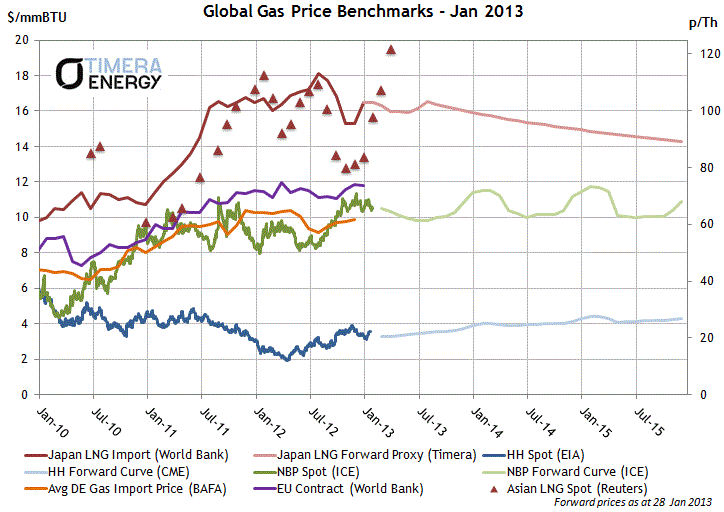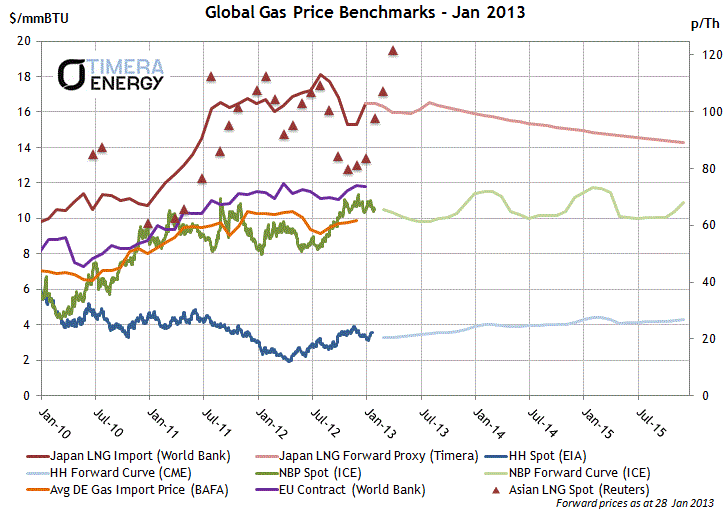A rapid expansion in Australian, African and US liquefaction capacity may drive global gas price convergence later this decade. But the global gas market in 2013 is still dominated by the pronounced inter-regional price divergence that has been a feature of the last two years. Since the Fukushima disaster, the average price of LNG delivered in Asia has been at a structural premium to prices in Europe, adjusted for the transport cost differential. However this average Asian price premium masks some substantial swings in Asian LNG spot pricing which are impacting the pricing and flow of gas into Europe.
One of the key themes of this blog has been the increasing influence of the global LNG market on European gas pricing dynamics. In order to provide some perspective on global gas market pricing, we regularly publish a chart of global gas and oil price benchmarks. In this article we overlay some Asian LNG spot price data (from Reuters) on the contract price benchmarks, shown as the red triangle data points in Chart 1.
Chart 1: Global gas price benchmarks Jan 2013

Chart 1: Global gas price benchmarks Jan 2013
The World Bank Asian LNG price (the red line in Chart 1) is an average import price, including both contract deliveries and spot purchases. As the large majority of cargoes are delivered under long term contracts, the price is a very good proxy for the average contract price.
Asian LNG spot price dynamics
Asian LNG spot prices represent the actual value at which flexible LNG cargoes are bought and sold in the spot market. While the majority of Asian LNG is delivered under long term oil-indexed contract, the more volatile spot market reflects the pricing of flexible cargoes at the margin. We summarised the relationship between spot and contract prices in a previous article:
Long term Asian LNG contract prices are primarily indexed to crude benchmarks such as Brent, WTI or JCC (albeit with much simpler structures than European contract prices, with less reliance on multi month lagged averaging and denominated in a single currency: USD). Any flexibility in these contracts can be optimised against available spot cargoes creating a direct link between contract and spot prices.
It is interesting to explore the relationship between spot and contract prices for Asian LNG over the last 12 months:
- Asian spot prices exceeded $18/mmbtu in early 2012 as robust demand from the large Asian spot buyers, China and India, coincided with aggressive Japanese to hedge gas fired power generation after the post Fukushima shutdown of its nuclear reactors.
- The threat of economic fallout from the European debt crisis and a marked slowdown in Chinese economic growth drove a significant correction in spot prices in March, before more aggressive buying, particularly by Japan to hedge power production for summer air-conditioning load.
- Over several weeks between May and July spot prices fell precipitously by $6/mmbtu with the debt crisis intensifying and Asian buyers well hedged over the summer (as we detailed here). After virtually drying up post Fukushima, spot LNG flows into Europe suddenly re-emerged supporting price levels around the $12/mmbtu mark.
- With the onset of winter, spot prices have recovered back towards the $18/mmbtu level as quickly as they fell into the summer. But this time the aggressive buying is coming from South America, specifically Brazil struggling to replace low hydro production. In turn, Chinese and Indian buyers are having to pay a premium to attract spot cargoes away from the Atlantic Basin.
- Last week, a small number of Asian LNG cargoes for March delivery were traded around $19.5/mmbtu, however prices for April delivery traded at a discount of several dollars lower in anticipation of lower demand from gas heating.
Price behaviour over the last 12 months illustrates the inelasticity of spot LNG supply. The resulting spot price volatility is a function of a limited volume of flexible cargoes available to respond to spot price signals and significant shorter term swings in demand from marginal buyers such as China, India, Brazil and Argentina.
The LNG spot market and Europe
The spot market for LNG may still be small relative to the contract market, but it is important because prices at the margin impact the behaviour of flexible LNG flows. The spot market is driven both by uncontracted LNG supply and LNG under long term contract with flexibility that can be exercised against spot prices (e.g. via cargo diversions, including reloading).
As global spot price signals become more pronounced and volatility continues, there will be an increasing pressure from long term contract buyers to re-negotiate increases in contract flexibility. This should improve the response of LNG flows to market price signals. But in the shorter term LNG spot price volatility is likely to continue and this has direct implications for the European gas market.
There is a dynamic relationship between the global LNG spot market and European gas hub price formation. The level of European hub prices relative to other global regions depends on whether uncontracted or flexible contracted cargoes are the marginal source of supply into Europe. This also drives the price coupling relationship between Europe and other regions.
An example can be seen over summer 2012 as European hubs provided a ‘soft floor’ for surplus LNG cargoes in the LNG spot market. At the point that a swing provider like Qatar can get a better netback price at European hubs than in Asia, spot LNG will flow back into Europe alleviating downward price pressure.
Less attractive for Europe would be a gas price squeeze, e.g. from a Russian pipeline supply outage, which could force European buyers to compete for spot cargoes with Asia and South America. This has yet to occur, but could drive gas hub prices and volatility sharply higher over a tight European winter.

